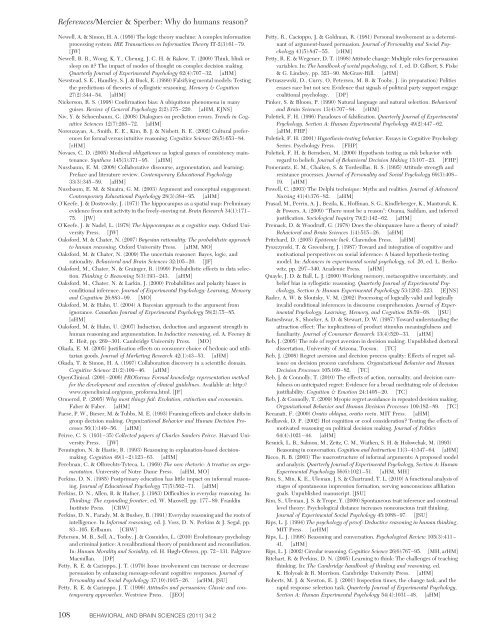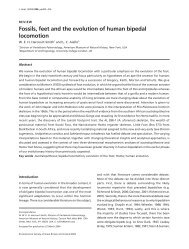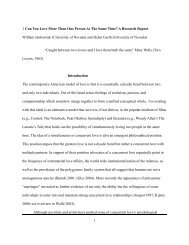Why do humans reason? Arguments for an argumentative theory
Why do humans reason? Arguments for an argumentative theory
Why do humans reason? Arguments for an argumentative theory
You also want an ePaper? Increase the reach of your titles
YUMPU automatically turns print PDFs into web optimized ePapers that Google loves.
References/Mercier & Sperber: <strong>Why</strong> <strong>do</strong> <strong>hum<strong>an</strong>s</strong> <strong>reason</strong>?Newell, A. & Simon, H. A. (1956) The logic <strong>theory</strong> machine: A complex in<strong>for</strong>mationprocessing system. IRE Tr<strong>an</strong>sactions on In<strong>for</strong>mation Theory IT-2(3):61–79.[JW]Newell, B. R., Wong, K. Y., Cheung, J. C. H. & Rakow, T. (2009) Think, blink orsleep on it? The impact of modes of thought on complex decision making.Quarterly Journal of Experimental Psychology 62(4):707–32. [aHM]Newstead, S. E., H<strong>an</strong>dley, S. J. & Buck, E. (1999) Falsifying mental models: Testingthe predictions of theories of syllogistic <strong>reason</strong>ing. Memory & Cognition27(2):344–54. [aHM]Nickerson, R. S. (1998) Confirmation bias: A ubiquitous phenomena in m<strong>an</strong>yguises. Review of General Psychology 2(2):175–220. [aHM, EJNS]Niv, Y. & Schoenbaum, G. (2008) Dialogues on prediction errors. Trends in CognitiveSciences 12(7):265–72. [aHM]Norenzay<strong>an</strong>, A., Smith, E. E., Kim, B. J. & Nisbett, R. E. (2002) Cultural preferences<strong>for</strong> <strong>for</strong>mal versus intuitive <strong>reason</strong>ing. Cognitive Science 26(5):653–84.[rHM]Novaes, C. D. (2005) Medieval obligationes as logical games of consistency mainten<strong>an</strong>ce.Synthese 145(3):371–95. [aHM]Nussbaum, E. M. (2008) Collaborative discourse, argumentation, <strong>an</strong>d learning:Preface <strong>an</strong>d literature review. Contemporary Educational Psychology33(3):345–59. [aHM]Nussbaum, E. M. & Sinatra, G. M. (2003) Argument <strong>an</strong>d conceptual engagement.Contemporary Educational Psychology 28(3):384–95. [aHM]O’Keefe, J. & Dostrovsky, J. (1971) The hippocampus as a spatial map: Preliminaryevidence from unit activity in the freely-moving rat. Brain Research 34(1):171–75. [JW]O’Keefe, J. & Nadel, L. (1978) The hippocampus as a cognitive map. Ox<strong>for</strong>d UniversityPress. [JW]Oaks<strong>for</strong>d, M. & Chater, N. (2007) Bayesi<strong>an</strong> rationality: The probabilistic approachto hum<strong>an</strong> <strong>reason</strong>ing. Ox<strong>for</strong>d University Press. [aHM, MO]Oaks<strong>for</strong>d, M. & Chater, N. (2009) The uncertain <strong>reason</strong>er: Bayes, logic, <strong>an</strong>drationality. Behavioral <strong>an</strong>d Brain Sciences 32:105–20. [JF]Oaks<strong>for</strong>d, M., Chater, N. & Grainger, R. (1999) Probabilistic effects in data selection.Thinking & Reasoning 5(3):193–243. [aHM]Oaks<strong>for</strong>d, M., Chater, N. & Larkin, J. (2000) Probabilities <strong>an</strong>d polarity biases inconditional inference. Journal of Experimental Psychology: Learning, Memory<strong>an</strong>d Cognition 26:883–99. [MO]Oaks<strong>for</strong>d, M. & Hahn, U. (2004) A Bayesi<strong>an</strong> approach to the argument fromignor<strong>an</strong>ce. C<strong>an</strong>adi<strong>an</strong> Journal of Experimental Psychology 58(2):75–85.[aHM]Oaks<strong>for</strong>d, M. & Hahn, U. (2007) Induction, deduction <strong>an</strong>d argument strength inhum<strong>an</strong> <strong>reason</strong>ing <strong>an</strong>d argumentation. In Inductive <strong>reason</strong>ing, ed. A. Feeney &E. Heit, pp. 269–301. Cambridge University Press. [MO]Okada, E. M. (2005) Justification effects on consumer choice of he<strong>do</strong>nic <strong>an</strong>d utilitari<strong>an</strong>goods. Journal of Marketing Research 42(1):43–53. [aHM]Okada, T. & Simon, H. A. (1997) Collaboration discovery in a scientific <strong>do</strong>main.Cognitive Science 21(2):109–46. [aHM]OpenClinical. (2001–2006) PRO<strong>for</strong>ma: Formal knowledge representation method<strong>for</strong> the development <strong>an</strong>d execution of clinical guidelines. Available at: http://www.openclinical.org/gmm_pro<strong>for</strong>ma.html. [JF]Ormerod, P. (2005) <strong>Why</strong> most things fail: Evolution, extinction <strong>an</strong>d economics.Faber & Faber. [aHM]Paese, P. W., Bieser, M. & Tubbs, M. E. (1993) Framing effects <strong>an</strong>d choice shifts ingroup decision making. Org<strong>an</strong>izational Behavior <strong>an</strong>d Hum<strong>an</strong> Decision Processes56(1):149–56. [aHM]Peirce, C. S. (1931–35) Collected papers of Charles S<strong>an</strong>ders Peirce. Harvard UniversityPress. [JW]Pennington, N. & Hastie, R. (1993) Reasoning in expl<strong>an</strong>ation-based decisionmaking.Cognition 49(1–2):123–63. [aHM]Perelm<strong>an</strong>, C. & Olbrechts-Tyteca, L. (1969) The new rhetoric: A treatise on argumentation.University of Notre Dame Press. [aHM, MO]Perkins, D. N. (1985) Postprimary education has little impact on in<strong>for</strong>mal <strong>reason</strong>ing.Journal of Educational Psychology 77(5):562–71. [aHM]Perkins, D. N., Allen, R. & Hafner, J. (1983) Difficulties in everyday <strong>reason</strong>ing. In:Thinking: The exp<strong>an</strong>ding frontier, ed. W. Maxwell, pp. 177–89. Fr<strong>an</strong>klinInstitute Press. [CRW]Perkins, D. N., Farady, M. & Bushey, B. (1991) Everyday <strong>reason</strong>ing <strong>an</strong>d the roots ofintelligence. In In<strong>for</strong>mal <strong>reason</strong>ing, ed. J. Voss, D. N. Perkins & J. Segal, pp.83–105. Erlbaum. [CRW]Petersen, M. B., Sell, A., Tooby, J. & Cosmides, L. (2010) Evolutionary psychology<strong>an</strong>d criminal justice: A recalibrational <strong>theory</strong> of punishment <strong>an</strong>d reconciliation.In: Hum<strong>an</strong> Morality <strong>an</strong>d Sociality, ed. H. Høgh-Olesen, pp. 72–131. PalgraveMacmill<strong>an</strong>. [DP]Petty, R. E. & Cacioppo, J. T. (1979) Issue involvement c<strong>an</strong> increase or decreasepersuasion by enh<strong>an</strong>cing message-relev<strong>an</strong>t cognitive responses. Journal ofPersonality <strong>an</strong>d Social Psychology 37(10):1915–26. [arHM, JSU]Petty, R. E. & Cacioppo, J. T. (1996) Attitudes <strong>an</strong>d persuasion: Classic <strong>an</strong>d contemporaryapproaches. Westview Press. [JEO]Petty, R., Cacioppo, J. & Goldm<strong>an</strong>, R. (1981) Personal involvement as a determin<strong>an</strong>tof argument-based persuasion. Journal of Personality <strong>an</strong>d Social Psychology41(5):847–55. [rHM]Petty, R. E. & Wegener, D. T. (1998) Attitude ch<strong>an</strong>ge: Multiple roles <strong>for</strong> persuasionvariables. In: The h<strong>an</strong>dbook of social psychology, vol. 1, ed. D. Gilbert, S. Fiske& G. Lindzey, pp. 323–90. McGraw-Hill. [aHM]Pietraszewski, D., Curry, O, Petersen, M. B. & Tooby, J. (in preparation) Politicserases race but not sex: Evidence that signals of political party support engagecoalitional psychology. [DP]Pinker, S. & Bloom, P. (1990) Natural l<strong>an</strong>guage <strong>an</strong>d natural selection. Behavioral<strong>an</strong>d Brain Sciences 13(4):707–84. [rHM]Poletiek, F. H. (1996) Para<strong>do</strong>xes of falsification. Quarterly Journal of ExperimentalPsychology, Section A: Hum<strong>an</strong> Experimental Psychology 49(2):447–62.[aHM, FHP]Poletiek, F. H. (2001) Hypothesis-testing behavior. Essays in Cognitive PsychologySeries. Psychology Press. [FHP]Poletiek, F. H. & Berndsen, M. (2000) Hypothesis testing as risk behavior withregard to beliefs. Journal of Behavioral Decision Making 13:107–23. [FHP]Pomer<strong>an</strong>tz, E. M., Chaiken, S. & Tordesillas, R. S. (1995) Attitude strength <strong>an</strong>dresist<strong>an</strong>ce processes. Journal of Personality <strong>an</strong>d Social Psychology 69(3):408–19. [aHM]Powell, C. (2003) The Delphi technique: Myths <strong>an</strong>d realities. Journal of Adv<strong>an</strong>cedNursing 41(4):376–82. [aHM]Prasad, M., Perrin, A. J., Bezila, K., Hoffm<strong>an</strong>, S. G., Kindleberger, K., M<strong>an</strong>turuk, K.& Powers, A. (2009) “There must be a <strong>reason</strong>”: Osama, Saddam, <strong>an</strong>d inferredjustification. Sociological Inquiry 79(2):142–62. [aHM]Premack, D. & Woodruff, G. (1978) Does the chimp<strong>an</strong>zee have a <strong>theory</strong> of mind?Behavioral <strong>an</strong>d Brain Sciences 1(4):515–26. [aHM]Pritchard, D. (2005) Epistemic luck. Claren<strong>do</strong>n Press. [aHM]Pyszczynski, T. & Greenberg, J. (1987) Toward <strong>an</strong>d integration of cognitive <strong>an</strong>dmotivational perspectives on social inference: A biased hypothesis-testingmodel. In: Adv<strong>an</strong>ces in experimental social psychology, vol. 20, ed. L. Berkowitz,pp. 297–340. Academic Press. [aHM]Quayle, J. D. & Ball, L. J. (2000) Working memory, metacognitive uncertainty, <strong>an</strong>dbelief bias in syllogistic <strong>reason</strong>ing. Quarterly Journal of Experimental Psychology,Section A: Hum<strong>an</strong> Experimental Psychology 53:1202–223. [EJNS]Rader, A. W. & Sloutsky, V. M. (2002) Processing of logically valid <strong>an</strong>d logicallyinvalid conditional inferences in discourse comprehension. Journal of ExperimentalPsychology: Learning, Memory, <strong>an</strong>d Cognition 28:59–68. [JSU]Ratneshwar, S., Shocker, A. D. & Stewart, D. W. (1987) Toward underst<strong>an</strong>ding theattraction effect: The implications of product stimulus me<strong>an</strong>ingfulness <strong>an</strong>dfamiliarity. Journal of Consumer Research 13(4):520–33. [aHM]Reb, J. (2005) The role of regret aversion in decision making. Unpublished <strong>do</strong>ctoraldissertation, University of Arizona, Tucson. [TC]Reb, J. (2008) Regret aversion <strong>an</strong>d decision process quality: Effects of regret salienceon decision process carefulness. Org<strong>an</strong>izational Behavior <strong>an</strong>d Hum<strong>an</strong>Decision Processes 105:169–82. [TC]Reb, J. & Connolly, T. (2010) The effects of action, normality, <strong>an</strong>d decision carefulnesson <strong>an</strong>ticipated regret: Evidence <strong>for</strong> a broad meditating role of decisionjustifiability. Cognition & Emotion 24:1405–20. [TC]Reb, J. & Connolly, T. (2009) Myopic regret avoid<strong>an</strong>ce in repeated decision making.Org<strong>an</strong>izational Behavior <strong>an</strong>d Hum<strong>an</strong> Decision Processes 109:182–89. [TC]Rec<strong>an</strong>ati, F. (2000) Oratio obliqua, oratio recta. MIT Press. [aHM]Redlawsk, D. P. (2002) Hot cognition or cool consideration? Testing the effects ofmotivated <strong>reason</strong>ing on political decision making. Journal of Politics64(4):1021–44. [aHM]Resnick, L. B., Salmon, M., Zeitz, C. M., Wathen, S. H. & Holowchak, M. (1993)Reasoning in conversation. Cognition <strong>an</strong>d Instruction 11(3–4):347–64. [aHM]Ricco, R. B. (2003) The macrostructure of in<strong>for</strong>mal arguments: A proposed model<strong>an</strong>d <strong>an</strong>alysis. Quarterly Journal of Experimental Psychology, Section A: Hum<strong>an</strong>Experimental Psychology 56(6):1021–51. [aHM, MH]Rim, S., Min, K. E., Ulem<strong>an</strong>, J. S. & Chartr<strong>an</strong>d, T. L. (2010) A functional <strong>an</strong>alysis ofstages of spont<strong>an</strong>eous impression <strong>for</strong>mation, serving nonconscious affiliationgoals. Unpublished m<strong>an</strong>uscript. [JSU]Rim, S., Ulem<strong>an</strong>, J. S. & Trope, Y. (2009) Spont<strong>an</strong>eous trait inference <strong>an</strong>d construallevel <strong>theory</strong>: Psychological dist<strong>an</strong>ce increases nonconscious trait thinking.Journal of Experimental Social Psychology 45:1088–97. [JSU]Rips, L. J. (1994) The psychology of proof: Deductive <strong>reason</strong>ing in hum<strong>an</strong> thinking.MIT Press. [arHM]Rips, L. J. (1998) Reasoning <strong>an</strong>d conversation. Psychological Review 105(3):411–41. [aHM]Rips, L. J. (2002) Circular <strong>reason</strong>ing. Cognitive Science 26(6):767–95. [MH, arHM]Ritchart, R. & Perkins, D. N. (2005) Learning to think: The challenges of teachingthinking. In: The Cambridge h<strong>an</strong>dbook of thinking <strong>an</strong>d <strong>reason</strong>ing, ed.K. Holyoak & R. Morrison. Cambridge University Press. [aHM]Roberts, M. J. & Newton, E. J. (2001) Inspection times, the ch<strong>an</strong>ge task, <strong>an</strong>d therapid response selection task. Quarterly Journal of Experimental Psychology,Section A: Hum<strong>an</strong> Experimental Psychology 54(4):1031–48. [aHM]108 BEHAVIORAL AND BRAIN SCIENCES (2011) 34:2




